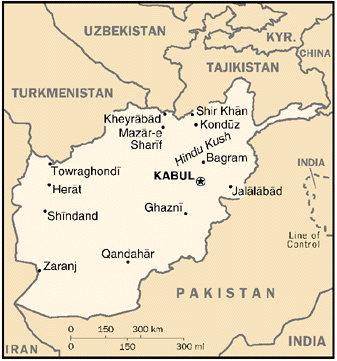

Status Quo Side: Soviets and Afghan Communists
Non-Status Quo Side: Afghan rebels
Region: South Asia & SW Asia
Conflict Type: External Intervention
Issues in Dispute: Governance, Strategic
Maps: [U Texas Afganistan maps]
Nationalist leader Daoud Khan in 1953 had tried to play the USSR against the US but fell in 1963 to a pro-US constitutional monarchy. In July 1973 a Daoud coup succeeded with aid from both branches of the Marxist PDPA party: Babrak Karmal's "Parcham", and the more militant "Khalq" of Nur Taraki and Hafizullah Amin. Daoud's failure to implement promised reforms reunited Khalq and Parcham in 1977. Violent demonstrations and arrests increased.
Daoud's death in a coup led to a Taraki government which the USSR recognized on April 30. The US maintained its ties. Karmal was exiled as an ambassador as violence continued. The Khalq government promoted land reform and women's rights which rural Afghans resisted. Widespread arrests led to Islamic fundamentalist attacks. On May 31 jets bombed rebel tribesmen. Increasing rural rebellions were met with bombing and napalm. In August Parcham officers were arrested in a coup implicating Karmal. Taraki and the USSR signed a treaty of friendship on December 4 and more Soviet advisers and equipment arrived. Rebel headquarters were established in Pakistan in January 1979 with reported aid from Iran, China and the US. US aid was cut following the US Ambassador's murder in February (with talk of Soviet complicity). As fighting escalated, Taraki was ousted by Amin in March, but his government faced increasingly serious trouble .
8,000 Soviet troops crossed into Afghanistan, followed by many more. Amin was executed on December 27 and Soviet-supported Karmal took power. The US embargoed grain sales, boycotted the Moscow Olympics and, along with India, China and Pakistan, supported rebel groups based in Pakistan. By 1986 Pakistan housed 3 million refugees, Iran 2 million. The UNGA annually condemned Soviet occupation and called for withdrawal. The USSR vetoed UNSC action, but good offices continued. With weapons such as US Stinger missiles, the rebels inflicted significant losses on Soviet aircraft, convoys and positions.
Soviet General Secretary Gorbachev announced withdrawal of all 115,000 Soviet troops beginning May 15. Following a UN-mediated agreement that permitted US aid to the rebels commensurate with Soviet aid to the Najibullah government, Soviet withdrawal was completed within nine months.
While US-Russian designs for Afghanistan's future gradually converged, civil war continued between the Najibullah regime and multiple opposition groups until Najibullah's overthrow, and subsequently between ten ethnic groups supported by the arms network created by US allies against the Soviet occupation. In September 1994 a powerful Pushtun group, the Taliban, stridently fundamentalist and employing brutal enforcement methods, took over half the country. Unsuccessful rebel drives on Kabul to unseat President Burhannudin Rabbani over the next two years devastated the civilian population. UN mediation efforts continued, and in May 1996 the two chief factions agreed to form an interim government. But the three ethnic minorities controlling ten Northern provinces united as the only means of stopping the Taliban advance, promising to restore a moderate Islamic state. They temporarily stopped the Taliban's expansion, but the Taliban controlled 19 provinces.
Iranian invasion threats in 1998 highlighted the isolation of the Taliban regime, officially supported only by Pakistan. The bombing of two US embassies in Africa on August 7 1998 resulted in a US cruise missile attack on the Afghan camp of international terrorism bankroller Osama bin Laden, who continues nevertheless to enjoy Taliban protection. In 2000 some modest improvements were reported in Taliban's repressive domestic policies.